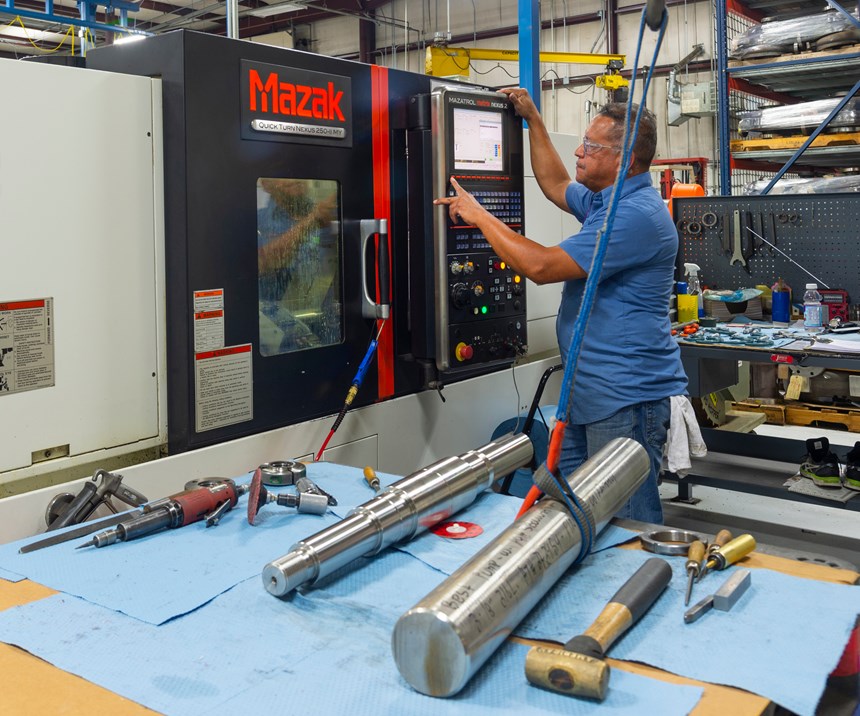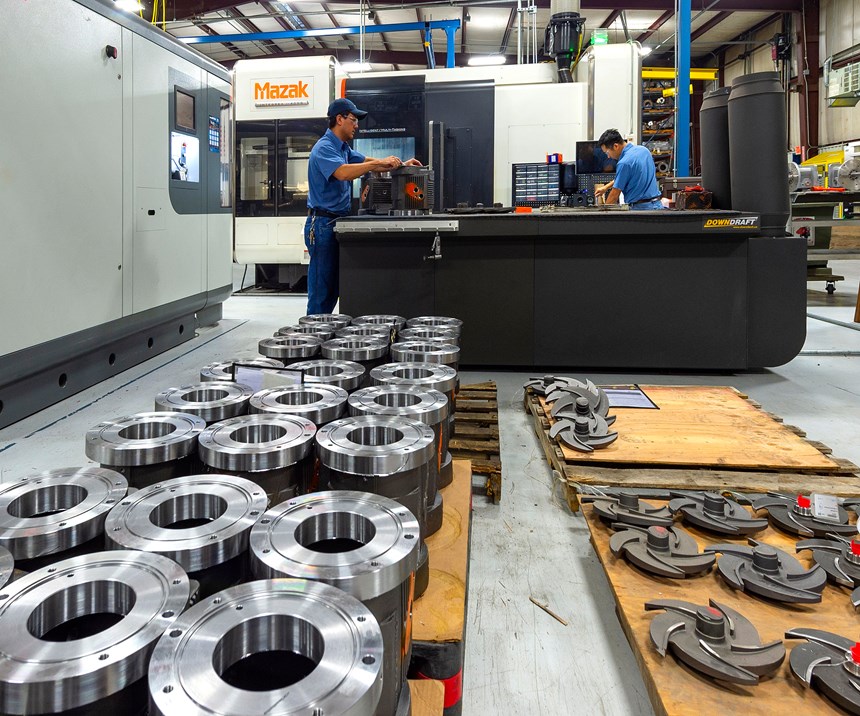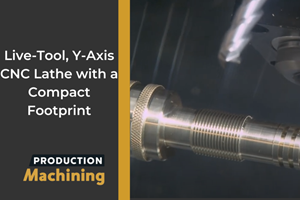Headquartered in Houston, Texas, this manufacturer of ANSI pumps for a range of industries stretching from mining and mineral to pharmaceutical to oil and gas is proud of its made in the USA philosophy. To stay ahead of competition, much of which comes from overseas, PumpWorks Industrial is on a constant mission to improve production efficiency. According to the company’s general manager, Michael Hohenstein, advanced machinery—along with machine monitoring software and the latest tooling—allows the shop to significantly reduce cycle times, which, in turn, plays a major role in achieving that much needed efficiency. As a result, the company has increased its productivity by 50 percent year over year.
Pump Design
PumpWorks, in business since 2014, currently has thousands of pumps in use in the field. The Houston location is the newest among the other PumpWorks brand manufacturers that date back to 1978. What sets PumpWorks’ ANSI pumps apart from the competition, according to Mr. Hohenstein, are the many design enhancements that are part of its standard pump offering that increase the overall reliability and maintainability of the pump without an increase in price to the customer.
Many of the features incorporated into the designs of the ANSI product lines were inspired by the company’s years of experience as a leading supplier of API 610 pumps, applying the American Petroleum Institute (API) standards. Some of these API-like features include fins on the power frame for heat dissipation, a flinger disc on the shaft that mists the internal oil for cooling the pump’s non-submerged bearings, and a sealant coating that is sprayed on the inside cavity of the power frame.
These specific features are focused on reducing bearing temperature and increasing the bearing life of the power frame, thus increasing reliability. The power frame also comes with a stainless steel shaft as part of the standard offering. Additionally, the base material used in the construction of the pumps is carbon steel for increased durability, according to Mr. Hohenstein, as compared with competitor ANSI pumps that are made from ductile iron and/or cast iron.
Through testing, PumpWorks determined its power frame runs bearing operating temperatures 15-20°F lower than competitor flood oil types and provides as much as 30% increased bearing life. This fact, together with the other API-like features, significantly boosts the pump’s reliability, which is paramount in the field. Pump failures can be very costly to the end users.
In addition to features that increase reliability, the PumpWorks pump is designed for easier service. A magnetic oil drain nut located on the side presents easy access, and a 1.00-inch diameter sealed and capped oil fill plug eliminates the risk of dirt and other contaminants falling into the power frame while providing ½ inch more access when filling. Site glasses located on both sides of the pump offer unobstructed views for checking oil levels regardless of how the pump is positioned at an application site.
Keeping Pace
Key to the shop’s effective pump manufacturing processes is to consistently keep pace with the advancements in machine tool technology. Doing so has allowed the shop to not only reduce its setup times, but also the number of setups required to process parts. With the latest machine tool capabilities, including multitasking, the shop achieves single setups for done-in-one part processing, which in turn shortens cycle times and boosts part quality and precision.
All the PumpWorks facilities/divisions use only Mazak machines. When the Houston facility opened, it too followed suit and incorporated two Integrex i-400S multitasking machines, one QTN-250 turning center, a Slant Turn Nexus (STN) 550 turning center, an HCN-6800 horizontal machining center and, most recently, an Integrex i-630V/6 multitasking machine.
The Integrex i-400S has a main integral spindle/motor headstock with a 40-hp, 3,300-rpm spindle that provides the shop with a range of machining capabilities, from heavy-duty cutting at low speeds to processing carbon steel and other alloy materials at high speeds. The machine’s rigidly clamping C axis indexes in 0.0001-degree increments for high accuracy, while its second 35-hp, 4,000-rpm turning spindle also features an integral spindle/motor to ensure high-efficiency machining for secondary operations. For additional multitasking functionality, the machine employs a 30-hp, 12,000-rpm milling spindle mounted in the rotating B-axis with a range of 240 degrees in 0.0001-degree indexing increments.
With a standard through-hole chuck package, the two-axis QTN-250 efficiently processes wide ranges of parts for PumpWorks. The machine, working with a bar feeder, provides a maximum bar feed diameter size of 2.6 inches and maximum part machining diameter size of 13.780 inches.
PumpWorks’ heavy-duty STN 550 employs a solidly constructed headstock with a 10.8"-diameter bore and a 1,000-rpm, 60-hp turning spindle that generates as much as 5,163 foot-pounds of torque. The machine’s spindle also accommodates a 21-inch chuck size.
Working together in a cell with the STN 550, the HCN-6800 II is equipped with a 50-hp, 10,000-rpm, CAT 50 spindle. The machine’s automatic toolchanger stores as many as 43 tools and accommodates maximum tool diameters of 10.24 inches. The machine’s NC rotary table rotates 90 degrees in 1.9 seconds and features 0.001-degree minimum increments for precise four-axis indexing and machining.
As the newest Mazak at PumpWorks, the Integrex i-630V/6 sports a 50-hp, 550-rpm turning spindle with C-axis control and a rigid CAT 50, 10,000-rpm milling spindle with a B-axis tilt of -30/+120 degrees. An automatic toolchanger supplies the milling spindle with as many as 160 tools for continuous cutting operations.
The STN 550 and HCN-6800 II cell produces one particular family of parts that, according to Mr. Hohenstein, is unfortunately impossible to machine using done-in-one processing. However, with this Mazak cell, the shop has basically eliminated any loss of time due to setups because parts move from one machine to the other, and custom fixturing produced in-house orients parts on zero without having to touch off. The fixturing locates the parts for the machines, thus eliminating the need for operators to have to perform the task.
“While the Mazaks do play a very key role in our manufacturing, they work in tandem with our custom in-house designed fixturing,” Operations Manager Charles Harvey explains. “With this innovative fixturing, we are often able to reduce three or four operations down to only one, and the fixtures also provide the strength and stability for taking heavy cuts to further reduce cycle times.”
PumpWorks does have automation working with its Integrex i-400S. But aside from that, the key is done-in-one production with its Mazaks. “What other shops might be doing with three or four machines in a row, we do with one multitasking Mazak,” Mr. Harvey says.
According to him, the shop doesn’t seek out machines based on a set of criteria. Instead, decisions are based on a product need. “We start with the part and work back toward acquiring a machine that will optimize our machining in terms of cycle times and part quality,” he says. “The capabilities that Mazak offers with its range of machines has been more than sufficient for what we need and gives us a competitive advantage.”
Wide Ranging Requirements
The shop produces about 3,600 pumps per year. In addition to machining, it does hydro testing, painting, assembly and packaging. Some components, such as bearings and gaskets, are purchased, but other than those, the shop produces all of the pumps’ components.
Part sizes can range from 6 inches in diameter to more than 30 inches in diameter. Tolerances are as tight as 0.0004 inch. The components of a pump include the casing, an impeller, a cover/stuffing box that encloses the impeller and the case/seals for what are known as the pump’s “wet-end components.” The pump’s power end has a shaft through its center as well as bearings and housing. These various components are assembled together per the customers’ requirements and are plug-and-play ready with the customers’ existing piping.
Depending on the application, the metallurgy of the pumps can vary significantly. If pumping a highly toxic or deadly chemical, for instance, the pump would be made from a high alloy material such as Hastelloy C. Other pumps may call for 100% nickel materials, but a pump used for oil and gas can be of carbon steel or stainless steel. From a machining standpoint, carbon steel is a bit more difficult to cut than a cast or ductile iron part. As a result of the wide-ranging applications, the shop has invested heavily in Mazak machining technology.
The shop works closely with its tooling suppliers and relies on their advice for machining the various tough materials. The shop is constantly looking to improve and brings tooling vendors in on a regular basis for evaluations and to learn about new tooling that will help the shop optimize machining processes and further reduce cycles. “And regardless of the type of new inserts or cutting tools, the power and capabilities of our Mazaks allow us to take full advantage of them,” Mr. Harvey adds.
One of the shop’s goals, according to Mr. Hohenstein, is to be an ANSI pump manufacturing leader in the market, and he believes that it is well on its way. It devotes itself to continuous improvements for everything from sales and marketing to machine and tooling technology with sustained internal investments. He foresees the development and manufacture of different types of pumps and product lines for both existing and new markets. For that new work and for increased volume of existing product lines, he knows PumpWorks will look to Mazak to provide the required manufacturing technology to produce those new lines.
Mazak Corp. | 800-231-1456 | mazakusa.com
PumpWorks | 855-979-9139 | pumpworks.com
Related Content
When a CNC Turn-Mill Doesn’t Turn
A shop in Big Sky Country uses a B-axis multitasking machine to produce complex, prismatic medical parts that require no turning complete from barstock.
Read MoreVideo Tech Brief: Live-Tool, Y-Axis CNC Lathe with a Compact Footprint
This small footprint, big-bore lathe offers a generous work envelope. The addition of Y-axis and live tooling enables milling, drilling and tapping for increased machine capabilities.
Read MoreA Mill-Turn’s Value for Machining Micro Gears
This leading manufacturer of non-lubricated robotic gears uses a seven-axis turn-mill to machine components from “amorphous” metals such as bulk metallic glasses.
Read MoreChoosing the Right Machine for Turned and Milled Medical Parts
The medical market is known for exceptionally tight tolerances and difficult materials, which means that selecting the proper machine is necessary to ensure a job is profitable.
Read MoreRead Next
The Impact of Multitasking in Today’s Shops
As the technology behind multitasking machines continues to advance, shops are reaping the benefits.
Read More5 Aspects of PMTS I Appreciate
The three-day edition of the 2025 Precision Machining Technology Show kicks off at the start of April. I’ll be there, and here are some reasons why.
Read MoreEmerging Leaders Nominations Now Open
Here’s your chance to highlight a young person in your manufacturing business who is on the path to be a future leader moving your company forward.
Read More











.jpg;maxWidth=300;quality=90)














